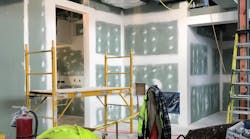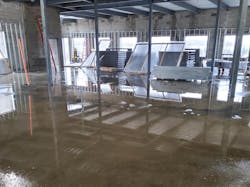Contractors may be accustomed to dealing with just about anything on the job. Worse-than-expected job conditions can be overlooked or overshadowed by even bigger problems. As a result, poor job-site conditions can unknowingly create safety risks, impact the morale of on-site workers, decrease productivity, prolong the schedule, and ultimately increase costs.
On your next walk around the job site, here are some things to look out for:
- Water flooding into the building from rain (Photo 1).
- Material or equipment preventing access to planned installation areas (Photo 2).
- Weather impacts, especially those resulting from delays in the schedule. Due to a delay in the schedule, work can be pushed into the winter months. For the crew in Photo 3, this meant shoveling ice to complete fixture installation on a canopy.
- Occupants re-occupying planned work areas without notice from the GC or owner. The foreman who had scheduled work in the corridors rearranged manpower upon finding the hallway re-decorated (Photo 4).
How to reduce the impact of poor site conditions
1. Plan. Use a work breakdown structure to plan for safety hazards and less-than-favorable conditions. When site conditions change, your work breakdown structure should be updated to reflect any increases in effort on installation tasks for the differing work environment.
2. Monitor productivity and schedule impacts due to poor site conditions. Using tools like short interval scheduling (SIS®), contractors can pinpoint where, when, and how unplanned site conditions impact scheduled work. SIS’s application of ASTM Standard E2691 helps to codify job-site obstacles across your projects, allowing field supervisors to report job conditions and obstacles as they arise so that the company and project manager can respond effectively.
The Figure illustrates the application of the standard and SIS tool. In this example, the foreman was running three school renovation projects and experiencing disruptions frequently due to issues with access to work areas within two of the buildings. The project team looked into this obstacle and learned that this had happened five times within a two-week period, disrupting a total of 32 hours of scheduled work. They were able to use this data to communicate the impact to the general contractor and come up with a solution to improve coordination. As a result, obstacles due to site conditions (such as the issue reported in the Figure and shown in Photo 4) were resolved.
Project schedules can also be used for long-term visibility of the work and monitoring of project delays. An EC&M article “Mastering the Electrical Work on a Mega Projects” discussed project scheduling and dealing with project delays through the use of Work Environment Management™ (WEM®).
Productivity tools like JPAC® can also allow contractors to monitor trends in productivity and document reasons for productivity loss that are driven by differing site conditions.
3. Communicate. With the right processes in place to plan for, monitor, and document project obstacles, project management teams can respond quickly and more effectively communicate with the contractor, owner, or project manager to express concerns. Unexpected site conditions drive costs for everyone and can delay the project’s completion. Using a data-driven approach allows the project team to be responsive and effectively relay the impact in terms of productivity and scheduled work.
4. Contract considerations. Including contingencies in your bid to request all information available to the owner and conducting your own extensive site investigations can decrease the risk of added costs on your projects.
Sydney Parvin is associate data analyst at MCA, Inc., Grand Blanc, Mich. She can be reached at [email protected]. Dr. Heather Moore is vice president of customer care and support. She can be reached at [email protected].








